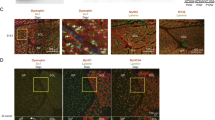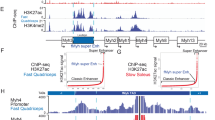Abstract
Adult skeletal muscles retain an adaptive capacity to switch between slow- and fast-twitch properties that are largely dependent on motoneuron activity. Our studies on the transcriptional regulation of the Troponin I slow (TnIs) and fast (TnIf) genes uncovered a dual mechanism of transcriptional enhancement and repression by a single activity pattern, that promotes the phenotypic differences among myofibers while preserving their adaptive capacity. Using the Tnf Fast Intronic Regulatory Element (FIRE), we initially demonstrated that fast-patterned activity (infrequent, high frequency depolarization) is necessary to up-regulate FIRE-dependent transcription and that its effect differs dramatically from muscle denervation. Hence, the “fast muscle program” is not a default state mimicked simply by denervation or muscle inactivity. Next, we found that slow-patterned activity (tonic, slow frequency stimulation) selectively represses FIRE-dependent transcription while enhancing transcription from the TnIs Slow Upstream Regulatory Element. Unexpectedly, repression of the TnIf FIRE by slow-patterned activity is mediated by an NFAT element that directly binds NFATc1, a transcription factor that translocates to the nucleus selectively by slow-pattern depolarization and has been implicated in the up-regulation of the slow muscle program. Transfection of siRNAs targeting NFATc1 or mutation of the TnIFIRE NFAT site result in the upregulation of FIRE-dependent transcription in slow muscle, but have no effect in fast muscle. These findings demonstrate a novel function of NFAT as a repressor of transcription of fast contractile genes in slow muscles and, more importantly, they illustrate how specific activity patterns can enhance the phenotypic differences among fibre-types by differentially regulating transcription in a use-dependent manner while retaining the adaptive properties of adult muscles.



Similar content being viewed by others
References
Banerjee-Basu S, Buonanno A (1993) cis-acting sequences of the rat troponin I slow gene confer tissue- and development-specific transcription in cultured muscle cells as well as fiber type specificity in transgenic mice. Mol Cell Biol 13(11):7019–7028
Buller AJ, Eccles JC, Eccles RM (1960) Interactions between motoneurones and muscles in respect of the characteristic speeds of their responses. J Physiol 150:417–439
Buonanno A, Rosenthal N (1996) Molecular control of muscle diversity and plasticity. Dev Genet 19(2):95–107
Butler-Browne GS, Bugaisky LB, Cuenoud S, Schwartz K, Whalen RG (1982) Denervation of newborn rat muscle does not block the appearance of adult fast myosin heavy chain. Nature 299(5886):830–833
Calvo S, Stauffer J, Nakayama M, Buonanno A (1996) Transcriptional control of muscle plasticity: differential regulation of troponin I genes by electrical activity. Dev Genet 19(2):169–181
Calvo S, Vullhorst D, Venepally P, Cheng J, Karavanova I, Buonanno A (2001) Molecular dissection of DNA sequences and factors involved in slow muscle-specific transcription. Mol Cell Biol 21(24):8490–8503
Chang Q, Gonzales M, Pinter MJ, Balice-Gordon RJ (1999) Gap junctional coupling and petterns of connexin expression among neonatal rat lumbar spinal motor neurons. J Neurosci 19:10813–10828
Condon K, Silberstein L, Blau HM, Thompson WJ (1990) Differentiation of fiber types in aneural musculature of the prenatal rat hindlimb. Dev Biol 138(2):275–295
DiMario JX, Stockdale FE (1997) Both myoblast lineage and innervation determine fiber type and are required for expression of the slow myosin heavy chain 2 gene. Dev Biol 188(1):167–180
DiMario JX, Fernyak SE, Stockdale FE (1993) Myoblasts transferred to the limbs of embryos are committed to specific fibre fates. Nature 362(6416):165–167
Eken T, Gundersen K (1988) Electrical stimulation resembling normal motor-unit activity: effects on denervated fast and slow rat muscles. J Physiol (Lond) 402:651–669
Esser K, Gunning P, Hardeman E (1993) Nerve-dependent and -independent patterns of mRNA expression in regenerating skeletal muscle. Dev Biol 159(1):173–183
Gundersen K (1985) Early effects of denervation on isometric and isotonic contractile properties of rat skeletal muscles. Acta Phsiol Scand 124(4):549–555
Gundersen K (1998) Determination of muscle contractile properties: the importance of the nerve. Acta Physiol Scand 162(3):333–341
Gundersen K, Eken T (1992) The importance of frequency and amount of electrical stimulation for contractile properties of denervated rat muscles. Acta Phsiol Scand. 145(1):49–57
Gutmann E, Melichna J, Syrovy I (1972) Contraction properties and ATPase activity in fast and slow muscle of the rat during denervation. Exp Neurol 36:488–497
Hallauer PL, Hastings KE (2002) TnIfast IRE enhancer: multistep developmental regulation during skeletal muscle fiber type differentiation. Dev Dyn 224:422–431
Hallauer PL, Bradshaw HL, Hastings KE (1993) Complex fiber-type-specific expression of fast skeletal muscle troponin I gene constructs in transgenic mice. Development 119(3):691–701
Hastings KEM, Emerson CP (1982) cDNA clone analysis of six co-regulated mRNAs encoding skeletal muscle contractile proteins. Proc Natl Acad Sci USA 79:1553–1557
Hennig R, Lomo T (1985) Firing patterns of motor units in normal rats. Nature 314(6007):164–166
Jerkovic R, Vitadello M, Kelly R, Buckingham M, Schiaffino S (1997) Fibre type-specific and nerve-dependent regulation of myosin light chain 1 slow promoter in regenerating muscle. J Muscle Res Cell Motil 18(3):369–373
Lomo T, Westgaard RH, Dahl HA (1974) Contractile properties of muscle: control by pattern of muscle activity in the rat. Proc R Soc Lond B Biol Sci 187(1086):99–103
Miller JB, Stockdale FE (1986) Developmental origins of skeletal muscle fibers: clonal analysis of myogenic cell lineages based on expression of fast and slow myosin heavy chains. Proc Natl Acad Sci U S A 83(11):3860–3864
Milner LD, Rafuse VF, Landmesser LT (1998) Selective fasciculation and divergent pathfinding decisions of embryonic chick motor axons projecting to fast and slow muscle regions. J Neurosci 18(9):3297–3313
Nakayama M, Stauffer J, Cheng J, Banerjee-Basu S, Wawrousek E, Buonanno A (1996) Common core sequences are found in skeletal muscle slow- and fast-fiber- type-specific regulatory elements. Mol Cell Biol 16(5):2408–2417
Personius KE, Balice-Gordon RJ (2001) Loss of correlated motor neuron activity during synaptic competition at developing neuromuscular synapses. Neuron 31(3):395–408
Personius KE, Belice-Gordon RJ (2001) Loss of correlated motor neuron activity during synaptic competition at developing neuromuscular synapses. Neuron 31:395–408
Pette D, Vrbova G (1992) Adaptation of mammalian skeletal muscle fibers to chronic electrical stimulation. Rev Physiol Biochem Pharmacol 120:115–202
Rafuse VF, Milner LD, Landmesser LT (1996) Selective innervation of fast and slow muscle regions during early chick neuromuscular development. J Neurosci 16(21):6864–6877
Rana ZA, Gundersen K, Buonanno A, Vullhorst D (2005) Imaging transcription in vivo: distinct regulatory effects of fast and slow activity patterns on promoter elements from vertebrate troponin I isoform genes. J Physiol 562(Pt 3):815–828
Rana ZA, Gundersen K, Buoannao A (2008) Activity-dependent repression of muscle genes by NFAT. Proc Natl Acad Sci 105(15):5921–5926
Salmons S, Sreter FA (1976) Significance of impulse activity in the transformation of skeletal muscle type. Nature 263(5572):30–34
Sartorelli V, Fulco M (2004) Molecular and cellular determinants of skeletal muscle atrophy and hypertrophy. Sci STKE 244:re11
Schiaffino S, Sandri M, Murgia M (2007) Activity-dependent signaling pathways controlling muscle diversity and plasticity. Physiol 22:269–278
Spangenburg EE, Booth FW (2003) Molecular regulation of individual skeletal muscle fibre types. Acta Physiol Scand 178(4):413–424
Thompson WJ, Condon K, Astrow SH (1990) The origin and selective innervation of early muscle fiber types in the rat. J Neurobiol 21(1):212–222
Vogel M, Landmesser L (1987) Distribution of fiber types in embryonic chick limb muscles innervated by foreign motoneurons. Dev Biol 119(2):481–495
Vrbova G, Navarrete R, Lowrie M (1985) Matching of muscle properties and motoneurone firing patterns during early stages of development. J Exp Biol 115:113–123
Windisch A, Gundersen K, Szabolcs MJ, Gruber H, Lomo T (1998) Fast to slow transformation of denervated and electrically stimulated rat muscle. J Physiol 510(Pt 2):623–632
Yu ZB, Gao F, Feng HZ, Jin JP (2007) Differential regulation of myofilament protein isoforms underlying the contractility changes in skeletal muscle unloading. Am J Physiol Cell Physiol 292(3):C1192–C1203
Yutzey KE, Kline RL, Konieczny SF (1989) An internal regulatory element controls troponin I gene expression. Mol Cell Biol 9(4):1397–1405
Author information
Authors and Affiliations
Corresponding author
Rights and permissions
About this article
Cite this article
Rana, Z.A., Gundersen, K. & Buonanno, A. The ups and downs of gene regulation by electrical activity in skeletal muscles. J Muscle Res Cell Motil 30, 255–260 (2009). https://doi.org/10.1007/s10974-010-9200-2
Received:
Accepted:
Published:
Issue Date:
DOI: https://doi.org/10.1007/s10974-010-9200-2




